The Beastiary
Mammals, Marsupials & Rodents
Anteaters
There are several varieties of this creature that inhabits the rainforests inland of Schendi, but the most notable is the Great Spined Anteater which can obtain lengths of more than twenty (20) feet. It is harmless unless you cross its path or disturb it. With heavily clawed forefeet, it can club, slash, lacerate, and eviscerate even a larl. When angered, it will utter a loud whistling sound. The anteaters feed on the multitudes of ants and termites of the rainforest.
"Any of several mammals that feed largely or entirely on ants or termites; any of a family (Myrmecophagidae) of New World edentates with a long narrow snout, a long tongue, and large salivary glands that includes the giant anteater and tamandua." — Merriam-Webster Dictionary ©2006.
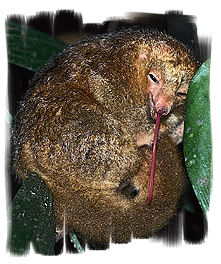
| 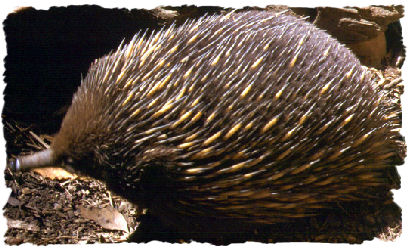
|
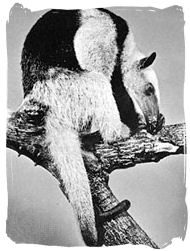
| Various species of anteaters pictured. Top left: The Silkey Anteater. Top right: The Spiney Anteater. Bottom left: The Giant Anteater |
More than six varieties of anteater are also found here, and more than twenty kinds of small, fleet, single-horned tabuk." — Explorers of Gor, page 312.
A great spined anteater, more than twenty feet in length, shuffled about the edges of the camp. We saw its long, thin tongue dart in and out of its mouth. "It is harmless," I said, "unless you cross its path or disturb it." It lived on the white ants, or termites, of the vicinity, breaking apart their high, towering nests of toughened clay, some of them thirty-five feet in height, with its mighty claws, then darting its four-foot-long tongue, coated with adhesive saliva, among the nest's startled occupants, drawing thousands in a matter of moments into its narrow, tubelike mouth. — Explorers of Gor, page 293.
Armored Gatch
A marsupial which inhabits the rainforests inland of Schendi.
"On the floor itself are also found several varieties of animal life, in particular marsupials, such as the armored gatch, and rodents, such as slees and ground urts." — Explorers of Gor, page 312.
Bosk
These creatures are large, shaggy, long-horned, ill-tempered bovine. Highly revered by the Wagon Peoples, these beasts are used for meat, milk and milk products, as well as used to pull heavy wagons. For more detailed information, see the Bosk page.
"The Bosk is a large, horned, shambling ruminant of the Gorean plains. It is herded below the Gorean equator by the Wagon Peoples, but there are Bosk herds on ranches in the north as well, and peasants often keep some of the animals." — Raiders of Gor, page 26.
"Each was drawn by two bosk, large brown creatures with spreading, polished horns, hung with beads. Their hoofs were also polished and their long, shaggy coats groomed to a shine." — Captive of Gor, page 65.
Frevet
A rather small, quick, mammalian insectivore that is often kept in insulae for insect control. 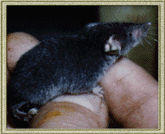 The frevet is never really described in the books. Most likely, because of the name, people assume the frevet is the Gorean counterpart for Earth's ferret. However, the ferret is a carnivore while the frevet is a insectivore. Ferrets were used in controlling rabbits and other plague-carrying rodents. Frevets are used in controlling insects. Most likely, the frevet is the counterpart of the shrew of Earth, and not the ferret, as evidenced in the quote below. I've seen an "official" site proclaim the frevet as common pets. The quote below calls them charming and that Tarl might grow fond of them, however, it never states anywhere that they were kept as pets in homes, just that they were kept in the insulae, though not ever insula furnishes them. Within the insula, they roam free to feed upon the insects.
The frevet is never really described in the books. Most likely, because of the name, people assume the frevet is the Gorean counterpart for Earth's ferret. However, the ferret is a carnivore while the frevet is a insectivore. Ferrets were used in controlling rabbits and other plague-carrying rodents. Frevets are used in controlling insects. Most likely, the frevet is the counterpart of the shrew of Earth, and not the ferret, as evidenced in the quote below. I've seen an "official" site proclaim the frevet as common pets. The quote below calls them charming and that Tarl might grow fond of them, however, it never states anywhere that they were kept as pets in homes, just that they were kept in the insulae, though not ever insula furnishes them. Within the insula, they roam free to feed upon the insects.
Etymology: Middle English shrewe evil person, scolding person, scolding woman, from Old English screawa shrew (small mammal)
"Any of numerous small mouselike chiefly nocturnal mammals of the family Soricidae which are most closely related to the moles, have a long pointed snout, very small eyes, and velvety fur, feed mainly on worms and insects." — Merriam-Webster Dictionary ©2004-2006
Depicted: Elephant Shrew
Insectivore — Any member of the mammalian order Insectivora, which includes the shrews, moles, hedgehogs, and several lesser known groups. Of about 400 species in the order, nearly 300 are shrews of the family Soricidae. All insectivores are small, as mammals go, the largest being about the size of a small rabbit. Shrews are probably the smallest of all mammals; some species of Sorex and Crocidura weigh as little as 2.5 grams (0.09 ounce). The general body plan varies greatly within the order. Many shrews are superficially mouselike but may be distinguished from mice and other rodents by the absence of chisel-like incisor teeth. Typical moles (Talpidae) and golden moles (Chrysochloridae) are cylindrical, burrowing animals with short, thick limbs and reduced tails and eyes. Hedgehogs (Erinaceidae) and some hedgehog-like tenrecs (Tenrecidae) are stocky animals whose upper surfaces are covered with short spines. Elephant shrews (Macroscelididae) are rather delicate animals, with long hindlegs like those of kangaroo rats or jerboas. Within the larger families the body plan is quite variable. Most insectivores live at or near ground level, except for the squirrel-like tree shrews and several aquatic moles, shrews, and tenrecs." — Encyclopaedia Britannica ©2003-2006
"Oh!" cried Boabissia, on the next landing. "An urt!"
"That is not an urt," said the proprietor. "They usually come out after dark. There is too much noise and movement fro them during the day." The small animal skittered backward, with a sound of claws on the boards. Its eyes gleamed in the reflected light of the lamp. "Generally, too, they do not come this high," said the proprietor. "That is a frevet." The frevet is a small, quick, mammalian insectivore. "We have several in the house," he said. "They control the insects, the beetles and lice, and such."
Boabissia was silent.
"Not every insula furnishes frevets," said the proprietor. "They are charming as well as useful creatures. You will probably grow fond of them. You will probably wish to keep your door open at night, for coolness, and to give access to them. They cannot gnaw through walls like urts, you know." …
"You see," said the proprietor. "You will come to like the frevets." We watched a large, oblong, flat-bodied black object, about a half hort in length, with long feelers, hurry toward a crack at the base of the wall. "That is a roach," he said. "They are harmless, not like the gitches whose bites are rather painful. Some of them are big fellows, too. But there aren't many of them around. The frevets see to it. Achiates prides himself on a clean house. — Mercenaries of Gor, pages 276-277.
Giani
This is a small cat-size panther, solitary in habits and not dangerous to man, which inhabits the rainforests inland of Schendi.
In the lower branches of the "ground zone" may be found, also, small animals, such as tarsiers, nocturnal jit monkeys, black squirrels, four-toed leaf urts, jungle varts and the prowling, solitary giani, tiny, cat-sized panthers, not dangerous to man." — Explorers of Gor, page 312.
Goat
Does 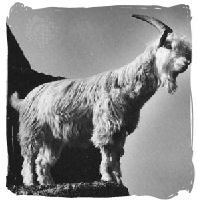 John Norman refer to the goats like those of Earth? or the verr? Was it another of his many errors made, or, was he simply confirming that the verr is a goat?
John Norman refer to the goats like those of Earth? or the verr? Was it another of his many errors made, or, was he simply confirming that the verr is a goat?
The warrior laughed and slapped his thigh. "You would have me believe that she is of High Caste," he said. "She is probably the daughter of a goat keeper." — Tarnsman of Gor, pages 115-116.
"Her father was a goat keeper by the swamp forests of Ar. As soon as we left the village, I put the bracelets on her and am taking her to Bristol, where she will tend my goats." — Tarnsman of Gor, page 122.
Guernon Monkey
A simian 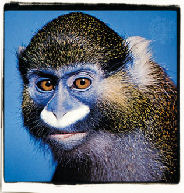 beasts of the rainforests inland of Schendi. On Earth, there is a monkey known as the guenon monkey; perhaps it was this monkey that was taken to Gor and somewhere along the way, the name was slightly altered.
beasts of the rainforests inland of Schendi. On Earth, there is a monkey known as the guenon monkey; perhaps it was this monkey that was taken to Gor and somewhere along the way, the name was slightly altered.
"We could hear the chattering of guernon monkeys about." — Explorers of Gor, page 307.
"[In the lower portion of the canopies, too, can be found.] Guernon monkeys, too, usually inhabit this level." — Explorers of Gor, page 311.
Horse
Mythological 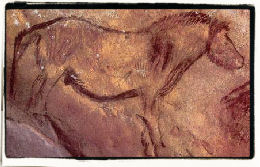 beast, depicted on cave walls found by Tarl Cabot in Torvaldsberg.
beast, depicted on cave walls found by Tarl Cabot in Torvaldsberg.
I looked at one of the pictographs. It was a man astride a quadruped. "Look," said I to the Forkbeard. "Interesting," said the Forkbeard. "It is a representation of a man riding a mythological beast, doubtless an illustration based upon some saga with which I am unfamiliar." He continued on. I lingered by the pictograph. I had seen nothing like it on Gor… There was no mistaking the quadruped on which the rider was mounted. It was a horse. — Marauders of Gor, page 230.
Hurt
A two-legged marsupial, domesticated and raised on ranches for its wool, used in making cloth.
"Cernus of Ar wore a coarse black robe, woven probably from the wool of the bounding, two-legged hurt, a domesticated marsupial raised in large numbers in the environs of several of Gor's northern cities. The hurt, raised on large fenced ranches, herded by the domesticated sleen and sheared by chained slaves, replaces its wool four times a year. The House of Cernus, I had heard, had interests in several of the Hurt Ranches near the city. " — Assassin of Gor, page 39.
"Two peasants walked by, in their rough tunics, knee-length, of the white wool of the Hurt." — Beasts of Gor, page 47.
"I looked up at skeins of wool hanging from the wooden poles between the flat roofs. They were quite colorful. The finest wool, however, is sheared in the spring from the bellies of the verr and hurt, and would, accordingly, not be available until later in the season. The wool market, as was to be expected, was now slow." — Tribesmen of Gor, page 50.
Jit Monkey
A small nocturnal simian which inhabits the rainforests inland of Schendi; also known as the tarsier. See: "Tarsier."
In the lower branches of the "ground zone" may be found, also, small animals, such as tarsiers, nocturnal jit monkeys, black squirrels, four-toed leaf urts, jungle varts and the prowling, solitary giani, tiny, cat-sized panthers, not dangerous to man." — Explorers of Gor, page 312.
Kaiila
The kaiila, 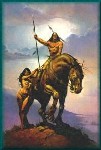 standing twenty to twenty-two (20-22) hands high, is a silken, lofty, graceful, long-necked and smooth-gaited beast. The paws of the kaiila are not hooves as that of the horse of Earth. The kaiila are claw-footed beasts, most likely for digging up roots, as well as a defense mechanism. The kaiila have two large eyes, one on each side of their head, with three eyelids, an adaptation to the environment it is conjectured, as each of these breeds lives upon the lands that are wracked by severe storms of wind and dust; the third lid is transparent, which permits the animal to move as it wishes under such extreme conditions. There are three species of kaiila which are mentioned: the southern kaiila, which serves as the mount of the Wagon Peoples; the Barrens kaiila, which serves as the mount of the red savages; and the desert, or sand, kaiila, which serves as the mount of the nomadic tribes of the desert. Extremely agile, the kaiila is one of the most dangerous creatures on Gor.
standing twenty to twenty-two (20-22) hands high, is a silken, lofty, graceful, long-necked and smooth-gaited beast. The paws of the kaiila are not hooves as that of the horse of Earth. The kaiila are claw-footed beasts, most likely for digging up roots, as well as a defense mechanism. The kaiila have two large eyes, one on each side of their head, with three eyelids, an adaptation to the environment it is conjectured, as each of these breeds lives upon the lands that are wracked by severe storms of wind and dust; the third lid is transparent, which permits the animal to move as it wishes under such extreme conditions. There are three species of kaiila which are mentioned: the southern kaiila, which serves as the mount of the Wagon Peoples; the Barrens kaiila, which serves as the mount of the red savages; and the desert, or sand, kaiila, which serves as the mount of the nomadic tribes of the desert. Extremely agile, the kaiila is one of the most dangerous creatures on Gor.
"I saw the kaiila tense, almost like larls, their flanks quivering, their large eyes intent upon me. I saw one of the long, triangular tongues dart out and back. Their long ears were laid back against the fierce, silken heads." — Nomads of Gor, page 15.
Kailiauk
The kaiiliauk is a large, very dangerous, migratory ruminant beast, tawny with red and brown markings on haunches, and trident-horned. The average male stands approximately ten (10) hands at the shoulder, weighing approximately 400 to 500 Gorean stone (1600 to 2000 pounds); the average female stands approximately eight (8) hands, weighing approximately 300 to 400 Gorean stone (1200 to 1600 pounds). Ruminant refers to a cud-chewing hoofed mammal, such as cattle, bison, sheep, goats, antelopes, deer, chevrotains, rhinoceros, giraffes, llamas and camels. This beast is important to the red savages of the Barrens, the major source for food and life. Its meat, bones, horns, hide, and sinew provide food, shelter, clothing, tools and weapons. The kaiiliauk is hunted generally on kaiilaback, it is hunted only on foot when in deep snow, as it almost helpless then.
"Even past me there thundered a lumbering herd of startled, short-bunked kailiauk, a stocky, awkward ruminant of the plains, tawny, wild, heavy, their haunches marked in red and brown bars, their wide heads bristling with a trident of horns…" — Nomads of Gor, page 2.
Larl
The larl is a 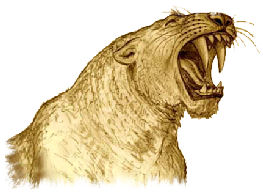 very large feline, the mountain (common) variety being tawny, red or black in color; the snow larls are larger with pelts of white. They are absolutely carnivorous and quite the capable predator. John Norman has described the beast as being leopardlike and pantherlike, but probably the larl is more close in nature and looks as that of the prehistoric saber-toothed felines, and hunt both solitary and in packs. These creatures are not cute kittenish pets. They are ferocious, strong, capable carnivorous predators. They cannot be tamed. They cannot be trained. Those that have attempted such have never lived very long to tell their tale.
very large feline, the mountain (common) variety being tawny, red or black in color; the snow larls are larger with pelts of white. They are absolutely carnivorous and quite the capable predator. John Norman has described the beast as being leopardlike and pantherlike, but probably the larl is more close in nature and looks as that of the prehistoric saber-toothed felines, and hunt both solitary and in packs. These creatures are not cute kittenish pets. They are ferocious, strong, capable carnivorous predators. They cannot be tamed. They cannot be trained. Those that have attempted such have never lived very long to tell their tale.
"…the larl, a tawny leopardlike beast indigenous to the Voltai and several of Gor's ranges, standing an incredible seven feet high at the shoulder and feared for its occasional hunger-driven visitations to the civilized plains below." — Tarnsman of Gor, page 147.
Leem
A small arctic rodent. Its furs are sold by the Red Hunters. Its natural enemy is the snow lart. See: "Swow Lart."
"… the leem, a small arctic rodent, some five to ten ounces in weight, which hibernates during the winter. The hunter drew forth from the bundle of furs two tiny pelts of the leem. These were brown, the summer coats of the animals." — Beasts of Gor, pages 74-75.
"The hunter pulled a pelt from the bundle of furs he carried. It was snowy white, and thick, the winter fur of a two-stomached snow lart. Such a pelt could sell in Ar for half a silver tarsk… The snow lart hunts in the sun. The food in the second stomach can be held almost indefinitely. It is filled in the fall and must last the larl through the winter night, which lasts months, the number of months depending on the latitude of his individual territory. It is not a large animal. It is about ten inches high and, weighs between eight and twelve pounds. It is mammalian, and has four legs. It eats bird's eggs and preys on the leem, a small arctic rodent, some five to ten ounces in weight, which hibernates during the winter." — Beasts of Gor, page 74.
Panther
The Forest 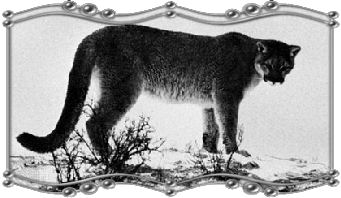 Panther is a large, carnivorous feline of the northern forests of Gor. The Jungle Panther is the more passive of the two. There is only mention of one coloration of these beasts, which is yellow, like that of the puma of earth.
Panther is a large, carnivorous feline of the northern forests of Gor. The Jungle Panther is the more passive of the two. There is only mention of one coloration of these beasts, which is yellow, like that of the puma of earth.
"Panthers, too, hunted largely at night, but, unlike the sleen, were not invariably nocturnal. The panther, when hungry, or irritable, hunts." — Hunters of Gor, page 106.
"We heard, as is not uncommon, the screams of forest panthers within the darkness of the trees." — Hunters of Gor, page 76.
"The next lot was an interesting one, consisting of two slave girls, clad in the skins of forest panthers, from the northern forests of Gor, and chained together by the throat." — Assassin of Gor, page 293.
"As I ran through the darkness, I suddenly saw, before me, some fifty or sixty yards away, four pairs of blazing eyes, a pride of forest panthers." — Captive of Gor, page 181.
"In certain of the cages, of heavy, peeled branches lashed together, there snarled and hissed forest sleen, in others there raged the dreadful tawny, barred panthers of the northern forests." — Captive of Gor, page 210.
"On the jungle floor, as well, are found jungle larls and jungle panthers, of diverse kinds, and many smaller catlike predators. These, on the whole, however, avoid men. They are less dangerous in the rain forest, generally, than in the northern latitudes. I do not know why this should be the case. Perhaps it Is because in the rain forest food is usually plentiful for them, and, thus, there is little temptation for them to transgress the boundaries of their customary prey categories. They will, however, upon occasion, particularly if provoked or challenged, attack with dispatch." — Explorers of Gor, page 312.
"He had worn at his loins the pelts of the yellow panther. He wore, too, the teeth of his beast as a necklace." — Explorers of Gor, page 237.
Porcupine
Prickly critters of Gor. Not much is mentioned of them, only that they are long-tailed and live within the jungles of the Schendi region.
"Here, too, may be found snakes and monkeys, gliding urts, leaf urts, squirrels, climbing, long-tailed porcupines, lizards, sloths, and the usual varieties of insects, ants, centipedes, scorpions, beetles and flies, and so on." — Explorers of Gor, page 311.
Quala
(pl. Qualae)
This is a small, tri-toed mammal, found often on the plains. The only three-toed mammal found on Earth in modern day is the three-toed sloth. However the qualae are not sloths. They could be kin to the perrissodactyls from the Pliocene period which were small, three-toed horses.
"… but as the tarn passed, it scattered into a scampering flock of tiny creatures, probably the small, three-toed mammals called qualae, dun-colored and with a stiff brushy mane of black hair." — Tarnsman of Gor, pages 141-142.
"Small straight bows, of course, not the powerful long bow, are, on the other hand, reasonably common on Gor, and these are often used for hunting light game, such as the brush-maned, three-toed Qualae, the yellow-pelted, single-horned Tabuk, and runaway slaves." — Raiders of Gor, page 4.
Slee
This is a small rodent which inhabits the rainforests inland of Schendi.
On the floor itself are also found several varieties of animal life, in particular marsupials, such as the armored gatch, and rodents, such as slees and ground urts." — Explorers of Gor, page 312.
Sleen
A ferocious mammal, canine in nature (not feline), yet almost reptilian in appearance, having 6 legs and 2 rows of teeth; nocturnal hunter.
"It is at night that the sleen hunts, that six-legged, long-bodied mammalian carnivore, almost as much a snake as an animal." — Outlaw of Gor, page 26.
"The vicious, six-legged sleen, large-eyed, sinuous, mammalian but resembling a furred, serpentine lizard, was a reliable, indefatigable hunter. He could follow a scent days old with ease, and then, perhaps hundreds of pasangs, and days, later, be unleashed for the sport of the hunters, to tear his victim to pieces. … — Raiders of Gor, page 105.
Hunting sleen are trained to scent out and destroy escaped slaves. Their senses are unusually keen. Tuchuks, in the south, as I recalled, had also used sleen to hunt slaves, and, of course, to protect their herds." — Raiders of Gor, page 106.
Sloth
Pictured at right, 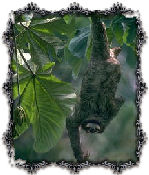 the sloth is a slow-moving, tree-dwelling mammal which hangs upside down from tree branches. Quite a lazy creature. Nothing much is mentioned of the sloth, other than it is found living in the jungles of the Schendi region.
the sloth is a slow-moving, tree-dwelling mammal which hangs upside down from tree branches. Quite a lazy creature. Nothing much is mentioned of the sloth, other than it is found living in the jungles of the Schendi region.
"Here, too, may be found snakes and monkeys, gliding urts, leaf urts, squirrels, climbing, long-tailed porcupines, lizards, sloths, and the usual varieties of insects, ants, centipedes, scorpions, beetles and flies, and so on." — Explorers of Gor, page 311.
Snow Lart
A mammalian with two-stomachs and four legs. The snow lart stands approximately 10" high and weighs between 8-12 pounds. It hunts in the sun and sleeps at night. The food in the second stomach can be held almost indefinitely. It is filled in the fall and can last through the winter night; a non-hibernating mammal. It eats bird's legs and preys on the leem.
"The hunter pulled a pelt from the bundle of furs he carried. It was snowy white, and thick, the winter fur of a two-stomached snow lart. Such a pelt could sell in Ar for half a silver tarsk… The snow lart hunts in the sun. The food in the second stomach can be held almost indefinitely. It is filled in the fall and must last the larl through the winter night, which lasts months, the number of months depending on the latitude of his individual territory. It is not a large animal. It is about ten inches high and, weighs between eight and twelve pounds. It is mammalian, and has four legs. It eats bird's eggs and preys on the leem, a small arctic rodent, some five to ten ounces in weight, which hibernates during the winter." — Beasts of Gor, page 74.
Squirrel
Pesky but cute rodent, which lives on the ground, as well as in trees. Likes to eat nuts and vegetation. Not much is mentioned of the squirrel found on Gor; usually brown in color, but black squirrels are common in certain regions as are flying squirrels.
which lives on the ground, as well as in trees. Likes to eat nuts and vegetation. Not much is mentioned of the squirrel found on Gor; usually brown in color, but black squirrels are common in certain regions as are flying squirrels.
In the lower branches of the "ground zone" may be found, also, small animals, such as tarsiers, nocturnal jit monkeys, black squirrels, four-toed leaf urts, jungle varts and the prowling,
solitary giani, tiny, cat-sized panthers, not dangerous to man." — Explorers of Gor, page 312.
"Here, too, may be found snakes and monkeys, gliding urts, leaf urts, squirrels, climbing, long-tailed porcupines, lizards, sloths, and the usual varieties of insects, ants, centipedes, scorpions, beetles and flies, and so on." — Explorers of Gor, page 311.
Tabuk
The yellow, singled-horned antelope of Gor; possibly not the species of antelope known today, but more specifically, the 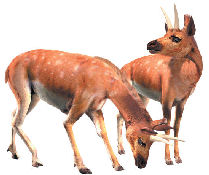 Cranioceras, a three-horned ruminant of the Miocene period. There are more than twenty (20) species of this animal found in the rainforests of Gor. The northern variety is much larger and much more fierce in temperament, massive in size, having an ivory horn over a yard long, probably more like elk of earth. Their sweet meat is roasted. The ivory of their horns is used for many things, one of which is carvings, of which the Innuit are fond. A famous herd of the northern tabuk is the Herd of Tancred. There have been those that think the tabuk hovers only in the thickets of trees, too fearful to emerge into open space. Antelope and deer even on Earth do not cower in the trees in absolute. It is not unknown for deer to wander onto desert land to enjoy a treat of pinon nuts. The female is known as a "doe."
Cranioceras, a three-horned ruminant of the Miocene period. There are more than twenty (20) species of this animal found in the rainforests of Gor. The northern variety is much larger and much more fierce in temperament, massive in size, having an ivory horn over a yard long, probably more like elk of earth. Their sweet meat is roasted. The ivory of their horns is used for many things, one of which is carvings, of which the Innuit are fond. A famous herd of the northern tabuk is the Herd of Tancred. There have been those that think the tabuk hovers only in the thickets of trees, too fearful to emerge into open space. Antelope and deer even on Earth do not cower in the trees in absolute. It is not unknown for deer to wander onto desert land to enjoy a treat of pinon nuts. The female is known as a "doe."
There are also tabuk of the plains regions. In many ways, Europe-Africa comes to mind when considering a large portion of Gor; the steppes of northern Europe where the large elk and reindeer are found, on down to the vast, great plains of Africa, which could be compared to the great plains of Turia, where vast herds of antelope and gazelle abound. The prairie tabuk, common to the Barrens, but, most likely, common to other prairies on Gor as well as other varieties of prairie tabuk, as evidenced in quotes. The prairie tabuk is described as gazelle-like, single-horned, tawny in coloring.
"Gripped in the talons of the tarn was the dead body of an antelope, one of the one-horned, yellow antelopes called tabuks that frequent the bright Ka-La-Na thickets of Gor." — Tarnsman of Gor, page 145.
"The
tabuk is the most common Gorean antelope, a small graceful animal, one-horned and yellow, that haunts the Ka-la-na thickets of the planet and occasionally ventures daintily into its meadows in search of berries and salt. It is also one of the favorite kills of a tarn." — Outlaw of Gor, page 126.
"More than six varieties of anteater are also found here, and more than twenty kinds of small, fleet, single-horned tabuk." — Explorers of Gor, page 312.
"Small straight bows, of course, not the powerful long bow, are, on the other hand, reasonably common on Gor, and these are often used for hunting light game, such as the brush-maned, three-toed Qualae, the yellow-pelted, single-horned Tabuk, and runaway slaves." — Raiders of Gor, page 4.
"In the distance, near the yellowish thicket, I saw a small, yellowish animal moving, delicately. It was far off and I could not see it well. I thought it might be a deer or gazelle. It disappeared into the thicket." — Captive of Gor, page 36.
"On the floor itself are also found several varieties of animal life, in particular marsupials, such as the armored gatch, and rodents, such as slees and ground urts. Several varieties of tarsk, large and small, also inhabit this zone. More than six varieties of anteater are also found here, and more than twenty kinds of small, fleet, single-horned tabuk." — Explorers of Gor, page 312.
"… a tabuk doe or a she-verr." — Explorers of Gor, page 76.
"They were northern tabuk, massive, tawny and swift, many of them ten hands at the shoulder, a quite different animal from the small, yellow-pelted, antelopelike quadruped of the south. On the other hand, they, too, were distinguished by the single horn of the tabuk. On these animals, however, that object, in swirling ivory, was often, at its base, some two and one-hall inches in diameter, and better than a yard in length. A charging tabuk, because of the swiftness of its reflexes, is a quite dangerous animal. Usually they are killed from a distance, often from behind shields, with arrows. — Beasts of Gor, page 152.
"At the end of the wall Imnak wept, seeing the strewn fields of slaughtered tabuk. The fur and hide of the tabuk provides the red hunters not only with clothing, but it can also be used for blankets, sleeping bags and other articles. The hides can serve for harnesses for the snow sleen and their white-skinned, female beasts. Too they may be used for buckets and tents, and for kayaks, the light, narrow hunting canoes of skin from which sea mammals may be sought. Lashings, harpoon lines, cords and threads can he fashioned from its sinews. Carved, the bone and horn of the animal can function as arrow points, needles, thimbles, chisels, wedges and knives. Its fat and bone marrow can be used as fuel. Too, almost all of the animal is edible. Even its eyes may be eaten and, from its stomach, the half-digested mosses on which it has been grazing." — Beasts of Gor, pages 169-170.
"Imnak sat in the corner of the tent, aimlessly whittling at a piece of tabuk horn. Once in a while he would stop and turn the ivory, and look at it … I watched him flake and trim ivory from the horn." — Beasts of Gor, page 252.
"Once a tabuk, a prairie tabuk, tawny in the Barrens, single-horned, gazellelike, had grazed nearby. It had browsed within feet of us. In a sense this had pleased me, suggesting that out quarry might be in the vicinity; in a sense it had displeased me, suggesting that abundant, alternative game might also be in the vicinity, the tabuk tending to travel in herds. Some varieties of prairie tabuk, interestingly, when sensing danger, tend to lie down. This is counterinstinctual for most varieties of tabuk, which, when sensing danger, tend to freeze, in a tense, standing position and then, if alarmed further, tend to scurry away, depending on their agility and speed to escape predators. The standing position, of course, as is the case with bipedalian creatures, tends to increase their scanning range. The response disposition of lying down, apparently selected fro in some varieties of tabuk, tends to be useful in an environment in which high grass is plentiful and one of the most common predators depends, primarily on vision to detect and locate its prey. This predator, as would be expected, normally attacks from a direction in which its shadow does not precede it. Any tabuk, of course, if it is sufficiently alarmed, will bound away. It can attain short-term speeds of from eighty to ninety pasangs an Ahn. Its evasive leaps, in the Gorean gravity, can cover from thirty to forty feet in length, and attain heights of ten to fifteen feet. Once we had heard two notes of the fleer, but, that time, as it had turned out, the source of the signal had not been Cuwignaka but, to our frustration, an actual fleer." — Blood Brothers of Gor, pages 316-317.
The Herd of Tancred
"Have you heard," he asked, "of the herd of Tancred? It is a herd of northern tabuk," said Samos, "a gigantic herd, one of several. The herd of Tancred winters in the rims of the northern forests south and east of Torvaldsland. In the spring, short-haired and hungry, they emerge from the forests hind migrate northward." He indicated the map. "They follow this route," he said, "emerging from the forest here, skirting Torvaldsland here, to the east, and then moving west above Torvaldsland, to the sea. They follow the shore of Thassa north, cross Ax Glacier here, like dark clouds on the ice, then continue to follow the shore north here, until they then turn eastward into the tundra of the polar basin, for their summer grazing. With the coming of winter, long-haired and fat, they return by the same route to the forests. This migration, like others of its kind, occurs annually." — Beasts of Gor, page 36.
Tarsier
A small nocturnal 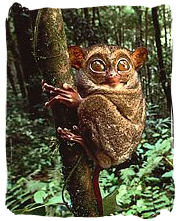 simian found in the rainforests inland of Schendi; also known as the jit monkey. See: "Jit Monkey."
simian found in the rainforests inland of Schendi; also known as the jit monkey. See: "Jit Monkey."
"The Tarsier (genus Tarsius) refers to any of three species of small primates, family Tarsiidae, intermediate in form between lemurs and monkeys. Tarsiers are found on several Southeast Asian islands including the Philippines, Celebes, Borneo, and Sumatra. They have long legs, short bodies, and rounded heads that can be rotated through 180°. Their faces are short, and the eyes, their most striking feature, are large and goggling. The ears are large, membranous, and almost constantly in motion. Tarsiers are about 9-16 cm (3.5-6 inches) long, excluding the tail, which is about twice that length. Their fur is thick, silky, and coloured gray to dark brown. Tarsiers cling vertically to trees and leap from trunk to trunk. They are well adapted to an arboreal life by the great elongation of their hindlimbs, by the expansion of the tips of the digits into disklike, adhesive pads, and by possession of the long, thin, tufted tail that serves as a balancer and prop. They are nocturnal animals and prey mainly on insects. A single young is produced in a fairly well-developed state, well furred and with eyes open; gestation may require about six months." — Encyclopaedia Britannica ©2003-2006
"In the lower branches of the 'ground zone' may be found, also, small animals, such as tarsiers, nocturnal jit monkeys, black squirrels, four-toed leaf urts, jungle varts and the prowling, solitary giani, tiny, cat-sized panthers, not dangerous to man." — Explorers of Gor, page 312.
Tarsk
A porcine animal 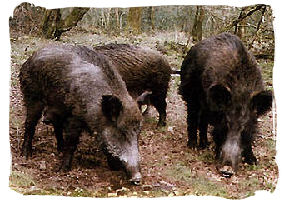 much like the Earth pig, having a bristly mane which runs down its spine to the base of the tail. Found in the wild, certain varieties may also be domesticated. The tarsk is a favorite meal of rence growers.
much like the Earth pig, having a bristly mane which runs down its spine to the base of the tail. Found in the wild, certain varieties may also be domesticated. The tarsk is a favorite meal of rence growers.
"Among the animals I saw many verrs; some domestic tarsks, their tusks sheathed; cages of flapping vulos, some sleen, some kaiila, even some bosk…" — Nomads of Gor, page 171.
"I heard the squealing of a domestic tarsk running nearby, its feet scuttling in the woven rence of the island, as on a mat. A child was crying out, chasing it." — Raiders of Gor, page 16.
"Several varieties of tarsk, large and small, also inhabit this zone." — Explorers of Gor, page 312.
"The tarsk, a small one, no more than forty pounds, tasked, snorting, bits of leaf scattering behind it, charged. It swerved, slashing with its curved tusks, and I only managed to turn it aside with the point of the raider's spear I carried. It had twisted hack on me with incredible swiftness. Such animals are best hunted from the back of kaiila with lances, in the open. They are cunning, persistent and swift. Suddenly it turned its short wide head, with that bristling mane running down its back to its tail." — Explorers of Gor, pages 345-346.
The Giant Tarsk is a large cousin of the tarsk, standing ten (10) hands high at the shoulder.
"The giant tarsk, which can stand ten hands at the shoulder, is even hunted with lances from tarnback." — Explorers of Gor, page 346.
Urt
A particularly nasty rodent of varying sizes and physical features. These can range in sizes from palm-sized, to rodents even the subway rats of New York City would run away from in terror.
"The tiny urt, a common rodent of Gorean cities…" — Tarnsman of Gor, page 187.
"… an urt, one of the small horned rodents of Gor…" — Outlaw of Gor, page 60.
"The urt is a loathsome, horned Gorean rodent; some are quite large, the size of wolves or ponies, but most are very small, tiny enough to be held in the palm of one hand." — Nomads of Gor, page 125.
"I found the tiny galley. In one corner, hunched over, nibbling, I saw an animal, about the size of a small dog. It lifted its snout and hissed at me, the hair about its neck and on its back suddenly bristling out with a crackle. — Captive of Gor, page 38.
"It crouched over a metallic container, round, not unlike a covered plate, that had been sprung open. The animal was silken. Its eyes blazed. It was mottled and tawny. It opened its mouth and hissed again. I saw it had three rows of needlelike teeth. It had only four legs, unlike the small animal I had seen earlier. Two hornlike tusks protruded from its jaw. Another two hornlike projections emerged from its head, just over its black, gleaming, wicked eyes. It had a long, whipping, hairless tail." — Captive of Gor, pages 38-39.
The Brush Urt is a small rodent which inhabits the plains.
"Some animals fled past me, away from the din, tabuk and brush urts." — Captive of Gor, page 249.
"I saw a tiny brush urt scurry past." — Hunters of Gor, page 106.
The Canal Urt is a large, vicious web-footed rodent which lives around the canals of the port cities.
"I found myself alone in the darkness. It was about an Ahn, I conjectured, before daylight. I trod the narrow walkway lining the canal. Then, suddenly, falling to my hands and knees, I threw up into the dark waters. I heard one of the giant canal urts twist in the water somewhere beneath me." — Raiders of Gor, page 119.
"Somewhere I heard the squealing and thrashing of two of the giant urts fighting in the water, among the floating garbage." — Raiders of Gor, pages 119-120.
" What are you going to do with her?" I asked.
"I am going to throw her to the urts," said Surbus.
"Please," she whispered, "please, Surbus."
"To the urts!" laughed Surbus, looking down at her. She closed her eyes.
The giant urts, silken and blazing-eyed, living mostly on the garbage in the canals, are not stranger to bodies, both living and dead, found cast into their waters. — Raiders of Gor, page 121 ."I heard an arrow flash into the water near me and heard a high-pitched pain squeal from one of the web-footed canal urts." — Raiders of Gor, page 170.
"I saw the silken head of an urt in the canal, a few feet from the boat. It was a large urt, some forty pounds in weight. They live on garbage cast into the canals, and on bound slaves who have not been pleasing." — Beasts of Gor, page 40.
The Forest Urt is a housecat-sized rodent which inhabits the northern forests.
"Over her shoulder she had two small, furred animals, hideous forest urts, about the size of cats…" — Captive of Gor, page 237.
The Gliding Urt inhabiting the rainforests inland of Schendi; much like a flying-squirrel.
"Here, too, may be found snakes and monkeys, gliding urts, leaf urts, squirrels, climbing, long-tailed porcupines, lizards, sloths, and the usual varieties of insects, ants, centipedes, scorpions, beetles and flies, and so on." — Explorers of Gor, page 311.
The Ground Urt inhabits the floor of the rainforests inland of Schendi.
"In the ground zone, and on the ground itself, are certain birds, some flighted, like the hook-billed gort, which preys largely on rodents, such as ground urts…" — Explorers of Gor, page 311.
The Leaf Urt is a tiny tree-dwelling rodent, having four toes, and inhabits the rainforests inland of Schendi.
"…a small animal, such as a leaf urt…" — Explorers of Gor, page 294.
"In the lower branches of the 'ground zone' may be found, also, small animals, such as tarsiers, nocturnal jit monkeys, black squirrels, four-toed leaf urts, jungle varts and the prowling, solitary giani, tiny, cat-sized panthers, not dangerous to man." — Explorers of Gor, page 312.
The Pack Urt< also known as the Giant Urt which lives in large packs, has been known to reach heights of four feet at the shoulder as described below:
"Through the bodies, an urt came pressing towards me. It was a large urt, darkly furred. It had one tusk broken at the side of its jaw. It was about four feet high at the shoulder, extremely large for this type of animal. It had a silver snout." — Players of Gor, page 283.
"It was a giant urt, fat, sleek, and white; it bared its three rows of needlelike white teeth at me and squealed in anger; two horns, tusks like flat crescents curved from its jaw; another two horns similar to the first, modifications of the bony tissue forming the upper ridge of the eye socket protruded over those gleaming eyes that seemed to feast themselves upon me…" — Outlaw of Gor, page 86.
The Prairie Urt is a small scavenger rodent of the plains.
"… the tiny brown prairie urts, scavengers…" — Nomads of Gor, page 266.
The Tree Urt is a small tree-climbing rodent found in the rainforests inland of Schendi.
"[In the level of the emergents.] Monkeys and tree urts, and snakes and insects, however, can also be found in this highest level." — Explorers of Gor, page 311.
The bite of an urt can be savage and deep, requiring the attention of a physician.
I felt my leg then caught in the jaws of an urt, like triple bands of steel, set with needles, and was dragged beneath the surface. I thrust my thumbs in its ears and tore it's head back from my leg. — Raiders of Gor, page 171.
I felt the folded sweep of Clitus' net behind me and I thrust back my hand, and hooked my fingers into its mesh. Bleeding and choking, shivering with cold, I was drawn from the water. In moments, trembling, half supported by two men-at-arms, I was conducted back to the investing wall. There, in the heat of a watch fire, I stripped away my clothes and took a cloak from Thurnock. Someone gave me a swallow of paga from a leather bota. Suddenly I laughed.
"Why do you laugh!" asked one of the men-at-arms.
"I am pleased to find myself alive," I said.
The men laughed. Thurnock clapped me on the shoulders. "So, too, are we, my captain," said Thurnock.
"What of your leg?" asked one of the men-at-arms.
"It is all right," I told him. I took another swig of paga. I had found that I could stand on the leg. It had been lacerated but none of the long, rough-edged wounds was deep. I would have it soon treated by a physician in my own holding. — Raiders of Gor, page 171 .
Some species of urts are migratory, which only proves dangerous for man if they get in their way. The smaller species destroy fields and granaries. Some urts are even domesticated, trained to attacking and killing, though without intelligence.
"It could be urts," said a man. "It is near the time of the year for their movements." Certain species of urts migrate twice a year. At such times, annually, it is usually necessary only to avoid them. People usually remain indoors when a pack is in their vicinity. There is little danger from these migrations unless one finds oneself in their direct path. The urt, on the whole, most species of which are quite small, large enough to be lifted in one hand, does not pose much direct threat to human beings. Then can destroy Sa-Tarna fields and force their way into granaries. Similarly urts of the sort which live on garbage cast into the canals will often, unhesitantly, attack swimmers. Certain forms of large, domesticated urt, incidentally, should be excepted from these remarks. They are especially bred for attacking and killing. Such animals, however, are inferior to sleen for such purposes. They also lack the tracking capabilities of the sleen. Similarly they lack its intelligence. There was at least one good additional reason, incidentally, for supposing that whatever might be perplexing the brigands was not urts. The urts do not make their kills neatly and silently. They normally attack in a pack. It is usually a messy business. There is usually much blood and screaming. — Players of Gor, page 184.
Vart
A blind, bat-like flying rodent, some of which are the size of a small dog. These creatures are often trained and used as weapons.
"The Vart is a small, sharp-toothed winged mammal, carnivorous, which commonly flies in flocks." — Explorers of Gor, page 36.
"There were several other creatures in the cases but I am not sure of their classification. I could, however, recognize a row of brown varts, clinging upside down like large matted fists of teeth and fur and leather on the heavy, bare, scarred branch in their case. I saw bones, perhaps human bones, in the bottom of their case." — Priest-Kings of Gor, page 191.
"Perhaps I most dreaded those nights filled with the shrieks of the vart pack, a blind, batlike swarm of flying rodents, each the size of a small dog. They could strip a carcass in a matter of minutes, each carrying back some fluttering ribbon of flesh to the recesses of whatever dark cave the swarm had chosen for its home. Moreover, some vart packs were rabid." — Outlaw of Gor, page 26.
"I had wanted to see both Tyros and Cos. Both lie some four hundred pasangs west of Port Kar, Tyros to the south of Cos, separated by some hundred pasangs from her. Tyros is a rugged island, with mountains. She is famed for her vart caves, and indeed, on the island, trained varts, batlike creatures, some the size of small dogs, are used as weapons." — Raiders of Gor, page 139.
The Jungle Vart is a relative of the northern vart, and inhabits the rainforests inland of Schendi.
"In the lower branches of the 'ground zone' may be found, also, small animals, such as tarsiers, nocturnal jit monkeys, black squirrels, four-toed leaf urts, jungle varts and the prowling, solitary giani, tiny, cat-sized panthers, not dangerous to man." — Explorers of Gor, page 312.
Verr
Also referred 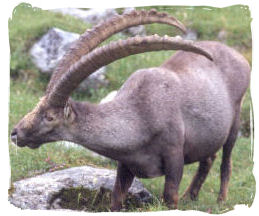 to as the Horned Verr, this is a mountain goat indigenous to the Voltai Mountains; wild, agile, ill-tempered, with long hair and spiraling horns; NOT a kangaroo-like animal as I have seen described on other sites. The domesticated verr, too, has long hair, but with a better temperament and smaller size; its milk is potable, as well as being used for cheese. The "wool" of the verr is actually the fur of its underbelly. The females are known as "she-verr."
to as the Horned Verr, this is a mountain goat indigenous to the Voltai Mountains; wild, agile, ill-tempered, with long hair and spiraling horns; NOT a kangaroo-like animal as I have seen described on other sites. The domesticated verr, too, has long hair, but with a better temperament and smaller size; its milk is potable, as well as being used for cheese. The "wool" of the verr is actually the fur of its underbelly. The females are known as "she-verr."
"… the agile and bellicose Gorean mountain goat, the long-haired, spiral horned verr. See — Tarnsman of Gor, pages 148-149.
"… the agile and bellicose Gorean mountain goat, the long-haired, spiral horned verr." — Tarnsman of Gor, pages 147.
"The verr was a mountain goat indigenous to the Voltai. It was a wild, agile, ill-tempered beast, long-haired and spiral horned. Among the Voltai crags it would be worth one's life to come within twenty yards of one." — Priest-Kings of Gor, page 63.
"… keeps for the small, long-haired domestic verr, less belligerent and sizeable than the wild verr of the Voltai Ranges." — Nomads of Gor, page 10.
"Behind them came another of their caste, leading two milk verr which he had purchased." — Beasts of Gor, page 47.
"… a tabuk doe or a she-verr. — Explorers of Gor, page 76.
"… the verr yield her kid with health to both…" — Marauders of Gor, page 35.
"Approaching him, her kirtle held high in two hands, it filled with verr dung, was blond, collared Thyri… She, holding her kirtle with her left hand, angrily scattered the dung about the sul plants. It would be left to a thrall to hoe it in about the plants." — Marauders of Gor, pages 103-104.
"Kaiila and verr are found at the oases, but not in great numbers. The herds of these animals are found in the desert. They are kept by nomads, who move them from one area of verr grass to another or from one water hole to another, as the holes, for the season, go dry. Smaller water sources are used in the spring, for these are the first to go dry, larger ones later in the year. No grass grows about these water holes because many animals are brought to them and graze it to the earth. They are usually muddy ponds, with some stunted trees about, centered in the midst of an extensive radius of grassless, cracked, dry earth. Meat, hides, and animal-hair cloth are furnished to the oases by the nomads. In turn, from the oases the nomads receive, most importantly, Sa-Tarna grain and the Bazi tea. They receive, as well, of course, other trade goods. Sa-Tarna is the main staple of the nomads. They, in spite of raising herds, eat very little meat. The animals are too precious for their trade value, and their hair and milk, to be often slaughtered for food. A nomad boy of fifteen will often have eaten meat no more than a dozen times in his life. Raiders, however, feast well on meat. The animals mean little to them and come to them cheaply." — Tribesmen of Gor, pages 37-38.
"I looked up at skeins of wool hanging from the wooden poles between the flat roofs. They were quite colorful. The finest wool, however, is sheared in the spring from the bellies of the verr and hurt, and would, accordingly, not be available until later in the season. The wool market, as was to be expected, was now slow." — Tribesmen of Gor, page 50.
Zeder
A small, carnivorous mammal, which resembles the sleen; inhabits the rainforests inland of Schendi; this creature grows to about two (2) feet long and weighs a mere eight to ten (8-10) pounds. A creature of the daylight, it can swim very well, and builds a stick-and-mud nest in the branches of a tree.
"Conspicuously absent in the rain forests of the Ua were sleen. There is, however, a sleenlike animal, though much smaller, about two feet in length and some eight to ten pounds in weight, the zeder, which frequents the Ua and her tributaries. It knifes through the water by day and, at night, returns to its nest, built from sticks and mud in the branches of a tree overlooking the water." — Explorers of Gor, page 312.
![]()
Special Note
Because of the differences in publishing the books, depending upon whether published in the U.S. or Europe, depending upon whether a first publishing or a Masquerade Books release, page numbers will often vary. All of my quotes are from original, first-printing U.S. publications (see The Books page for a listing of publishers and dates) with the exception of the following books:
- Tarnsman of Gor (2nd Printing, Balantine)
- Outlaw of Gor (11th Printing, Balantine)
- Priest-Kings of Gor (2nd Printing, Balantine)
- Assassin of Gor (10th Printing, Balantine)
- Raiders of Gor (15th Printing, Balantine)
- Captive of Gor (3rd Printing, Balantine)
Disclaimer
These pages are not written for any specific home, but rather as informational pages for those not able to get ahold of the books and read them yourself. Opinions and commentaries are strictly my own personal views, therefore, if you don't like what you are reading — then don't. The information in these pages is realistic to what is found within the books. Many sites have added information, assuming the existences of certain products and practices, such as willowbark and agrimony for healing, and travel to earth and back for the collection of goods. I've explored the books, the flora, the fauna, and the beasts, and have compiled from those mentioned, the probabilities of certain practices, and what vegetation mentioned in the books is suitable for healing purposes, as well as given practicalities to other sorts of roleplaying assumptions.